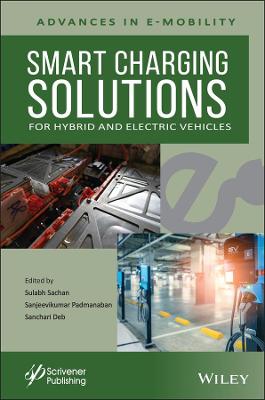Smart Charging Solutions for Hybrid and Electric Vehicles
 -15%
portes grátis
-15%
portes grátis
Smart Charging Solutions for Hybrid and Electric Vehicles
Deb, Sanchari; Sanjeevikumar, P.; Sachan, Sulabh
John Wiley & Sons Inc
03/2022
464
Dura
Inglês
9781119768951
15 a 20 dias
780
1 Smart Charging: An Outlook Towards its Role and Impacts, Enablers, Markets, and the Global Energy System 1
Bikash Sah and Praveen Kumar
1.1 Introduction to Smart Charging 2
1.1.1 Context of SMART 3
1.1.2 Approaches 5
1.1.3 Contributions 5
1.2 Types of Charging 6
1.2.1 Uncoordinated Charging 6
1.2.2 Coordinated Charging 7
1.2.3 Smart Charging 8
1.3 Impact of Smart Charging on Global Energy Systems 14
1.3.1 On the Grid Side 15
1.3.2 On the Demand Side 15
1.3.3 Overall Infrastructure 16
1.4 Types of Smart Charging 16
1.5 Entities of a Smart-Charging System 18
1.5.1 Operators: Generation, Transmission, and Distribution 19
1.5.2 Controllers 19
1.5.3 Aggregators 20
1.5.4 Communication System 20
1.5.5 Stakeholders 22
1.5.5.1 Policymakers 22
1.5.5.2 Manufacturers 23
1.5.5.3 Service and Support Providers 23
1.5.5.4 Consumers 23
1.5.6 Market 24
1.6 Enablers of Smart Charging 24
1.7 Control Architectures 26
1.7.1 Centralized 26
1.7.2 Decentralized 27
1.7.3 Comments on Suitability 28
1.8 Outlook towards Smart Charging 30
1.9 Conclusion 31
References 32
2 Influence of Electric Vehicles on Improvements in the Electric Distribution Grid 39
Michela Longo, Wahiba Yaici and Dario Zaninelli
2.1 Introduction 39
2.2 Evolution of the Distribution System 41
2.2.1 Present and Next Challenges of the Distribution System 41
2.2.2 Energy Planning 43
2.2.3 Impacts on the Consumption of Energy Sources 45
2.2.4 Impacts of the Consumption on Distribution Networks 45
2.2.5 Evolution towards Smart Grids 46
2.3 Electric Mobility 50
2.3.1 Electric Vehicle Classification 51
2.3.2 Electric Mobility Maturity in Italy 53
2.3.2.1 Technological Maturity 54
2.3.2.2 Regulatory Maturity 54
2.3.2.3 Market Maturity 54
2.3.3 Electric Vehicle Market 57
2.3.4 Italian EV Market 58
2.3.5 The Influence of Batteries 59
2.3.6 Future Scenarios 61
2.3.7 Plans for the Diffusion of Charging Systems in Italy - PNIRE 64
2.3.8 Models and Diffusion Plans 65
2.3.8.1 The ANCI Guidelines 66
2.3.9 Charging Infrastructure 66
2.4 Charging Infrastructure for Electric Vehicles 68
2.4.1 State-of-the-Art Charging Infrastructure 68
2.4.2 Charging Modes 69
2.4.2.1 Mode 1: Charging in Domestic Environment, Slow (6-8 h) up to 16 A 70
2.4.2.2 Mode 2: Charging in Domestic Environment, Slow (3-4 h) up to 32 A 71
2.4.2.3 Mode 3: Recharge in Domestic and Public Environment, Slow (6-8 h) or Fast (30 min - 1 h) 71
2.4.2.4 Mode 4: Charging in Public Environment, Fast (10-30 min) (Charging in Direct Current) 71
2.4.3 Charging Poles 72
2.4.4 Charging Connectors 75
2.4.5 Pilot Circuit 77
2.4.6 Complete Pilot Circuit 78
2.4.7 Simplified Pilot Circuit 78
2.5 Conclusion 79
References 79
3 Smart Charging Strategies for the Changing Grid 83
Chandana Sasidharan and Shweta Kalia
3.1 Introduction 83
3.2 Charging Strategy based on Vehicle Type 86
3.3 Mapping of Charging Strategies 90
3.4 Evaluation of Charging Strategies 99
References 100
4 Pricing Schemes for Smart Charging 105
Ahad Abessi, Vahid Safari and Mohammad Shadnam Zarbil
Abbreviations 105
Nomenclature 106
4.1 Introduction 108
4.2 Concepts and Issues in Charging Pricing 109
4.3 Different Models of Charging Stations' Dynamic Pricing 111
4.4 Classification of Charging Pricing Models 112
4.4.1 Stochastic Dynamic Pricing 114
4.4.1.1 Profit of Charging Stations 116
4.4.1.2 Customer Satisfaction 117
4.4.1.3 Effect on the Power Grid 117
4.4.1.4 Multi-Objective Optimization Framework 118
4.4.2 Distributed Dynamic Pricing Policy Method 119
4.4.2.1 Distributed Dynamic Pricing Strategy 119
4.4.2.2 Usage-Based Dynamic Pricing (UDP) 121
4.4.2.3 Distributed Demand Response Pricing (D2R) 122
4.4.2.4 Quadratic Cost Function Pricing (QCF) 123
4.4.3 Integrated Dynamic Pricing and Scheduling of EV Charging Stations 123
4.4.4 Competitive Charging Station Pricing 124
4.4.4.1 Charger Station Pricing Game (CSPG) 125
4.4.5 Negotiation Pricing in Charging Stations 126
4.4.5.1 Initial Price of EV User 127
4.4.5.2 Charging Station Operator Initial Price 127
4.4.5.3 Strategy of Price Adjustment for Charging Station Operator 128
4.4.5.4 Price Adjustment Strategy of EV User 128
4.4.6 Charging Pricing of Fast Charging Stations for the Voltage Control of Distribution Network 129
4.4.6.1 The Lower-Layer Optimization Model 129
4.4.6.2 The Upper-Layer Optimization Model 131
4.4.7 Online Reinforcement Learning Approach for Dynamic Pricing 132
4.5 Electricity Pricing of Vehicle Discharging to Grid 134
4.5.1 Scheme of Discharge Pricing 135
4.5.2 Some Common Schemes of Discharge Pricing 137
4.6 Electricity Pricing Currently Used at Charging Stations 137
4.7 Effect of Charging Pricing on Economic Competitiveness of Electric Vehicles 139
4.8 Conclusion 140
References 141
5 Management of Electric Vehicles Using Automatic Learning Algorithms: Application in Office Buildings 143
Andres Alonso Rodriguez, Luis Perdomo, Ameena Al-sumaiti, Francisco Santamaria and Sergio Rivera
5.1 Introduction 143
5.2 Proposed Charging Strategy 145
5.3 Test Bed and Implementation Results 150
5.4 Conclusion 155
References 156
6 High-Power Charging Strategies of EV Batteries and Energy Storage 159
Marta Zurek-Mortka and Jerzy R. Szymanski
Abbreviations 159
6.1 Introduction 160
6.2 EV Battery Set Model 163
6.3 Case Study of Charging High Power Li-Ion Battery for Energy Storage and Electric Work Machines 165
6.4 Proposed Constant Current and Constant Voltage Method for EV Battery Charging 169
6.5 Simulation Tests of EV Battery Charging 170
6.6 Conclusions 172
References 173
7 Integration of Fast Charging Stations for Electric Vehicles with the Industrial Power System 175
Marta Zurek-Mortka and Jerzy R. Szymanski
Abbreviations 176
7.1 Introduction 176
7.2 Structure of Hybrid EV Fast Charging Station 178
7.3 Use of Drive Voltage Frequency Converter for Charging EV Batteries 180
7.4 Fast Charging Converter Integrated with 600V DC Microgrid 183
7.5 Simulation and Experimental Study of Drive Voltage Frequency Converter Used to Charge EV Batteries 187
7.6 Conclusions 192
References 193
8 Regulatory Framework for Smart Charging in Hybrid and Electric Vehicles: Challenges, Driving Forces, and Lessons for Future Roadmap 195
Rajkumar Viral and Divya Asija
List of Abbreviations 196
8.1 Introduction 197
8.1.1 Status of Adopted EV Technology 199
8.1.2 Prospects and Current Market for Smart Charging 202
8.1.3 Status of International Intervened Framework 204
8.2 EV Charging Technology and Smart Charging 205
8.2.1 EV Charging Technology 205
8.2.1.1 Existent Charging Technologies for EVs 207
8.2.1.2 Emergent Charging Technologies for EVs 208
8.2.2 Smart Charging 209
8.2.3 Smart Charging: Current Status and Technological Advancement 211
8.2.3.1 Smart Charging Powered by Service Provider or Grid Operator Needs 211
8.2.3.2 Smart Charging Powered by EV Owners or Building Needs 211
8.2.4 Affordability and Current Infrastructure 214
8.2.4.1 Charging Stations 214
8.2.4.2 The Charger 215
8.2.5 Major Threats in Smart Charging 218
8.3 Smart Charging Standards 220
8.3.1 Standards Developed by IEC 220
8.3.1.1 IEC61851 Standard 220
8.3.1.2 IEC 61980 Standard 221
8.3.1.3 IEC62196 Standard 221
8.3.2 SAE Standards 221
8.3.2.1 SAEJ2293 Standard 221
8.3.2.2 SAEJ1772 Standard 221
8.3.2.3 SAEJ1773 Standard 221
8.3.2.4 SAEJ2847 and SAEJ2836 Standard 222
8.3.2.5 SAEJ2931 Standard 222
8.3.2.6 SAEJ2954 and SAEJ2954 Standard 222
8.3.3 Safety Standards for EV 222
8.3.3.1 NFPA Standards 222
8.3.3.2 NEC 625 223
8.3.3.3 NEC 626 223
8.4 Regulatory Framework 223
8.4.1 International Smart Charging Framework 223
8.4.2 Role of Agents in Smart Charging 226
8.4.3 Regulatory Challenges of Smart Charging and Impact on Global Energy Market 227
8.5 Conclusions and Discussion 229
References 230
9 EV Fast Charging Station Planning with Renewable Energy Sources: A Case Study of Durgapur System 233
Dr. Ashish Kumar Bohre, Dr. Partha Sarathee Bhowmik and Dr. Baseem Khan
9.1 Introduction 234
9.2 Modeling of System 236
9.2.1 Solar PV 236
9.2.2 Battery Storage System (BSS) 237
9.2.3 System Converter 237
9.2.4 Diesel Generator 237
9.2.5 Load Profile 238
9.2.6 Electric Vehicle Fast Charging Station (EV-FCS) Characteristics and Performance 238
9.3 Case Study on Solar and Wind Data 240
9.4 Problem Description and Methodology 242
9.4.1 Cost of Energy (COE) 245
9.4.2 Annual Savings 245
9.4.3 Internal Rate of Return 245
9.4.4 Simple Payback 245
9.4.5 Pollutant Emissions 246
9.5 Results and Discussion 246
9.5.1 System Analysis without EV Fast Charging Stations (EV-FCS) 247
9.5.2 System Analysis with EV Fast Charging Stations (EV-FCS) 261
9.6 Conclusions 278
9.7 Acknowledgment 279
References 279
10 Game Theory Approach for Electric Vehicle Charge Management Considering User Behavior 283
Lokesh Kumar Panwar
Nomenclature 284
10.1 Introduction 285
10.2 Problem Formulation 288
10.3 Profit Maximization Game 292
10.4 Existence and Uniqueness of Nash Equilibrium of Profit Maximization Game 294
10.5 Results and Discussion 296
10.6 Conclusion 302
Appendix A 302
References 304
11 A Novel SMES Based Charging System for Electric Vehicles in Smart Grids 307
Ubaid ur Rehman
Nomenclature 307
List of Abbreviations 307
List of Variables 308
11.1 Introduction 308
11.2 System Modeling 310
11.3 Impact Analysis of SME'S on SG Performance while Accommodating EVs 314
11.4 Conclusion 318
References 319
12 A Novel Intelligent Route Planning Framework for Electric Vehicles with Consideration of Waiting Time in Delhi 321
Lokesh Kumar Panwar
12.1 Introduction 322
12.2 Problem Description 324
12.2.1 Travelling Cost between Two Edges 325
12.2.2 Charging Cost at CS 325
12.2.3 Travelling Time Between Two Edges 325
12.2.4 Waiting Time at CS 326
12.3 Reinforcement Learning (RL) Based EV Navigation System 326
12.3.1 Objective Functions 327
12.3.2 Online Learning and Estimation Waiting Time 328
12.3.3 RL Based Navigation Method 329
12.4 Results and Discussion 331
12.4.1 Simulation Environment 331
12.4.2 Benchmark Cases 333
12.4.3 Distributed Learning Simulation 336
12.5 Conclusion 338
References 338
13 Smart Charging Management for Autonomous Vehicles: A Smart Solution for Smart Cities & Societies: COVID 19 341
Nadia Adnan, Sharina Md Nordin, Malik Fawaz Saleh and Shouvik Sanyal
13.1 Introduction 342
13.2 Autonomous Vehicles: A Promise for Next-Generation Transportation Systems 345
13.3 How Autonomous Vehicle Standards Ensure Safety 346
13.4 Autonomous Cars and Smart Cities 347
13.5 Benefits of Autonomous Vehicles 348
13.6 Adoption Perspectives for Autonomous Vehicles: COVID 19 Situation 349
13.7 During the Fight of Pandemic Situation: How Autonomous Vehicles are Used 349
13.8 Smart Charging Management for Autonomous Vehicles 349
13.9 Challenges Involved in Self Driving Vehicles (V2X) Driving the Development of Autonomous Vehicles 352
13.10 Discussion 354
13.11 Conclusion 354
13.12 Acknowledgment 355
References 356
14 Electric Vehicle Integrated Virtual Power Plants: A Systematic Review 361
Sanchari Deb, Sulabh Sachan, Mohammad Saad Alam and Samir M Shariff
Abbreviations 361
14.1 Introduction 362
14.2 Overview of VPP 364
14.2.1 Definitions of VPP 364
14.2.2 Components of VPP 365
14.2.3 Classification of VPP 366
14.2.4 Benefits of VPP 366
14.3 Global Scenario 366
14.4 Framework for VPP 368
14.5 Research Initiatives 370
14.6 EV Integrated VPP 370
14.7 Conclusions 375
References 375
15 Optimal Location of EV Charging Stations by Modified Direct Search Algorithm 381
Sanchari Deb, Sulabh Sachan and Toni Zhimomi
Abbreviations 381
15.1 Introduction 382
15.1.1 Background 382
15.1.2 Existing Works 383
15.1.3 Contribution 383
15.2 Problem Formulation 383
15.3 Methodology 389
15.3.1 Division of Search Space 390
15.3.2 Arrangement of Elements of Search Space 391
15.3.3 Size Reduction of Search Space 392
15.3.4 Evaluation of Objective Function 393
15.4 Numerical Analysis 393
15.5 Conclusion 395
References 395
16 Recent Trends and Technologies of Electric Vehicles and Their Wireless Charging Methods: A Review 399
D. R. Karthik, Mallikarjunareddy Bandi, Naveenkumar Marati, Balraj Vaithilingam and Kathirvel Karuppazhagi
16.1 Introduction 400
16.2 FAME Status 401
16.3 Basic Operation of WPT of EVs 403
16.4 Components of WPT System 405
16.5 Advancements in WPT and Electric Vehicle Technology 407
16.6 Electric Vehicle Status in India 408
16.7 Standards of Electrical Vehicles, Infrastructure, and WPT 411
16.8 Conclusion 416
References 416
17 Techno-Economic Issues of Grid Connected Large Photovoltaic Plants of Smart City Prayagraj to the EV Charging Station: A Case Study (A Case Study of 5 MW Photovoltaic Power Plant at Prayagraj) 419
Satendra Kumar Singh Kushwaha, Satyprakash, Akhilesh Kumar Gupta, Akbar Ahmad, Bandi Mallikarjuna Reddy and Narendra Kumar Ch
17.1 Introduction 420
17.2 PV Generation Feasibility Study for Prayagraj for EV Charging Stations 422
17.3 Modeling and Challenges of Grid Integrated Photovoltaic System 425
17.4 Real-Time Challenges of 5MW Solar Plant at Naini, Prayagraj, India 429
17.5 Whole System Layout and Description 430
17.6 Cost Analysis of Complete PV System 431
17.7 Conclusion 433
References 433
Index 437
1 Smart Charging: An Outlook Towards its Role and Impacts, Enablers, Markets, and the Global Energy System 1
Bikash Sah and Praveen Kumar
1.1 Introduction to Smart Charging 2
1.1.1 Context of SMART 3
1.1.2 Approaches 5
1.1.3 Contributions 5
1.2 Types of Charging 6
1.2.1 Uncoordinated Charging 6
1.2.2 Coordinated Charging 7
1.2.3 Smart Charging 8
1.3 Impact of Smart Charging on Global Energy Systems 14
1.3.1 On the Grid Side 15
1.3.2 On the Demand Side 15
1.3.3 Overall Infrastructure 16
1.4 Types of Smart Charging 16
1.5 Entities of a Smart-Charging System 18
1.5.1 Operators: Generation, Transmission, and Distribution 19
1.5.2 Controllers 19
1.5.3 Aggregators 20
1.5.4 Communication System 20
1.5.5 Stakeholders 22
1.5.5.1 Policymakers 22
1.5.5.2 Manufacturers 23
1.5.5.3 Service and Support Providers 23
1.5.5.4 Consumers 23
1.5.6 Market 24
1.6 Enablers of Smart Charging 24
1.7 Control Architectures 26
1.7.1 Centralized 26
1.7.2 Decentralized 27
1.7.3 Comments on Suitability 28
1.8 Outlook towards Smart Charging 30
1.9 Conclusion 31
References 32
2 Influence of Electric Vehicles on Improvements in the Electric Distribution Grid 39
Michela Longo, Wahiba Yaici and Dario Zaninelli
2.1 Introduction 39
2.2 Evolution of the Distribution System 41
2.2.1 Present and Next Challenges of the Distribution System 41
2.2.2 Energy Planning 43
2.2.3 Impacts on the Consumption of Energy Sources 45
2.2.4 Impacts of the Consumption on Distribution Networks 45
2.2.5 Evolution towards Smart Grids 46
2.3 Electric Mobility 50
2.3.1 Electric Vehicle Classification 51
2.3.2 Electric Mobility Maturity in Italy 53
2.3.2.1 Technological Maturity 54
2.3.2.2 Regulatory Maturity 54
2.3.2.3 Market Maturity 54
2.3.3 Electric Vehicle Market 57
2.3.4 Italian EV Market 58
2.3.5 The Influence of Batteries 59
2.3.6 Future Scenarios 61
2.3.7 Plans for the Diffusion of Charging Systems in Italy - PNIRE 64
2.3.8 Models and Diffusion Plans 65
2.3.8.1 The ANCI Guidelines 66
2.3.9 Charging Infrastructure 66
2.4 Charging Infrastructure for Electric Vehicles 68
2.4.1 State-of-the-Art Charging Infrastructure 68
2.4.2 Charging Modes 69
2.4.2.1 Mode 1: Charging in Domestic Environment, Slow (6-8 h) up to 16 A 70
2.4.2.2 Mode 2: Charging in Domestic Environment, Slow (3-4 h) up to 32 A 71
2.4.2.3 Mode 3: Recharge in Domestic and Public Environment, Slow (6-8 h) or Fast (30 min - 1 h) 71
2.4.2.4 Mode 4: Charging in Public Environment, Fast (10-30 min) (Charging in Direct Current) 71
2.4.3 Charging Poles 72
2.4.4 Charging Connectors 75
2.4.5 Pilot Circuit 77
2.4.6 Complete Pilot Circuit 78
2.4.7 Simplified Pilot Circuit 78
2.5 Conclusion 79
References 79
3 Smart Charging Strategies for the Changing Grid 83
Chandana Sasidharan and Shweta Kalia
3.1 Introduction 83
3.2 Charging Strategy based on Vehicle Type 86
3.3 Mapping of Charging Strategies 90
3.4 Evaluation of Charging Strategies 99
References 100
4 Pricing Schemes for Smart Charging 105
Ahad Abessi, Vahid Safari and Mohammad Shadnam Zarbil
Abbreviations 105
Nomenclature 106
4.1 Introduction 108
4.2 Concepts and Issues in Charging Pricing 109
4.3 Different Models of Charging Stations' Dynamic Pricing 111
4.4 Classification of Charging Pricing Models 112
4.4.1 Stochastic Dynamic Pricing 114
4.4.1.1 Profit of Charging Stations 116
4.4.1.2 Customer Satisfaction 117
4.4.1.3 Effect on the Power Grid 117
4.4.1.4 Multi-Objective Optimization Framework 118
4.4.2 Distributed Dynamic Pricing Policy Method 119
4.4.2.1 Distributed Dynamic Pricing Strategy 119
4.4.2.2 Usage-Based Dynamic Pricing (UDP) 121
4.4.2.3 Distributed Demand Response Pricing (D2R) 122
4.4.2.4 Quadratic Cost Function Pricing (QCF) 123
4.4.3 Integrated Dynamic Pricing and Scheduling of EV Charging Stations 123
4.4.4 Competitive Charging Station Pricing 124
4.4.4.1 Charger Station Pricing Game (CSPG) 125
4.4.5 Negotiation Pricing in Charging Stations 126
4.4.5.1 Initial Price of EV User 127
4.4.5.2 Charging Station Operator Initial Price 127
4.4.5.3 Strategy of Price Adjustment for Charging Station Operator 128
4.4.5.4 Price Adjustment Strategy of EV User 128
4.4.6 Charging Pricing of Fast Charging Stations for the Voltage Control of Distribution Network 129
4.4.6.1 The Lower-Layer Optimization Model 129
4.4.6.2 The Upper-Layer Optimization Model 131
4.4.7 Online Reinforcement Learning Approach for Dynamic Pricing 132
4.5 Electricity Pricing of Vehicle Discharging to Grid 134
4.5.1 Scheme of Discharge Pricing 135
4.5.2 Some Common Schemes of Discharge Pricing 137
4.6 Electricity Pricing Currently Used at Charging Stations 137
4.7 Effect of Charging Pricing on Economic Competitiveness of Electric Vehicles 139
4.8 Conclusion 140
References 141
5 Management of Electric Vehicles Using Automatic Learning Algorithms: Application in Office Buildings 143
Andres Alonso Rodriguez, Luis Perdomo, Ameena Al-sumaiti, Francisco Santamaria and Sergio Rivera
5.1 Introduction 143
5.2 Proposed Charging Strategy 145
5.3 Test Bed and Implementation Results 150
5.4 Conclusion 155
References 156
6 High-Power Charging Strategies of EV Batteries and Energy Storage 159
Marta Zurek-Mortka and Jerzy R. Szymanski
Abbreviations 159
6.1 Introduction 160
6.2 EV Battery Set Model 163
6.3 Case Study of Charging High Power Li-Ion Battery for Energy Storage and Electric Work Machines 165
6.4 Proposed Constant Current and Constant Voltage Method for EV Battery Charging 169
6.5 Simulation Tests of EV Battery Charging 170
6.6 Conclusions 172
References 173
7 Integration of Fast Charging Stations for Electric Vehicles with the Industrial Power System 175
Marta Zurek-Mortka and Jerzy R. Szymanski
Abbreviations 176
7.1 Introduction 176
7.2 Structure of Hybrid EV Fast Charging Station 178
7.3 Use of Drive Voltage Frequency Converter for Charging EV Batteries 180
7.4 Fast Charging Converter Integrated with 600V DC Microgrid 183
7.5 Simulation and Experimental Study of Drive Voltage Frequency Converter Used to Charge EV Batteries 187
7.6 Conclusions 192
References 193
8 Regulatory Framework for Smart Charging in Hybrid and Electric Vehicles: Challenges, Driving Forces, and Lessons for Future Roadmap 195
Rajkumar Viral and Divya Asija
List of Abbreviations 196
8.1 Introduction 197
8.1.1 Status of Adopted EV Technology 199
8.1.2 Prospects and Current Market for Smart Charging 202
8.1.3 Status of International Intervened Framework 204
8.2 EV Charging Technology and Smart Charging 205
8.2.1 EV Charging Technology 205
8.2.1.1 Existent Charging Technologies for EVs 207
8.2.1.2 Emergent Charging Technologies for EVs 208
8.2.2 Smart Charging 209
8.2.3 Smart Charging: Current Status and Technological Advancement 211
8.2.3.1 Smart Charging Powered by Service Provider or Grid Operator Needs 211
8.2.3.2 Smart Charging Powered by EV Owners or Building Needs 211
8.2.4 Affordability and Current Infrastructure 214
8.2.4.1 Charging Stations 214
8.2.4.2 The Charger 215
8.2.5 Major Threats in Smart Charging 218
8.3 Smart Charging Standards 220
8.3.1 Standards Developed by IEC 220
8.3.1.1 IEC61851 Standard 220
8.3.1.2 IEC 61980 Standard 221
8.3.1.3 IEC62196 Standard 221
8.3.2 SAE Standards 221
8.3.2.1 SAEJ2293 Standard 221
8.3.2.2 SAEJ1772 Standard 221
8.3.2.3 SAEJ1773 Standard 221
8.3.2.4 SAEJ2847 and SAEJ2836 Standard 222
8.3.2.5 SAEJ2931 Standard 222
8.3.2.6 SAEJ2954 and SAEJ2954 Standard 222
8.3.3 Safety Standards for EV 222
8.3.3.1 NFPA Standards 222
8.3.3.2 NEC 625 223
8.3.3.3 NEC 626 223
8.4 Regulatory Framework 223
8.4.1 International Smart Charging Framework 223
8.4.2 Role of Agents in Smart Charging 226
8.4.3 Regulatory Challenges of Smart Charging and Impact on Global Energy Market 227
8.5 Conclusions and Discussion 229
References 230
9 EV Fast Charging Station Planning with Renewable Energy Sources: A Case Study of Durgapur System 233
Dr. Ashish Kumar Bohre, Dr. Partha Sarathee Bhowmik and Dr. Baseem Khan
9.1 Introduction 234
9.2 Modeling of System 236
9.2.1 Solar PV 236
9.2.2 Battery Storage System (BSS) 237
9.2.3 System Converter 237
9.2.4 Diesel Generator 237
9.2.5 Load Profile 238
9.2.6 Electric Vehicle Fast Charging Station (EV-FCS) Characteristics and Performance 238
9.3 Case Study on Solar and Wind Data 240
9.4 Problem Description and Methodology 242
9.4.1 Cost of Energy (COE) 245
9.4.2 Annual Savings 245
9.4.3 Internal Rate of Return 245
9.4.4 Simple Payback 245
9.4.5 Pollutant Emissions 246
9.5 Results and Discussion 246
9.5.1 System Analysis without EV Fast Charging Stations (EV-FCS) 247
9.5.2 System Analysis with EV Fast Charging Stations (EV-FCS) 261
9.6 Conclusions 278
9.7 Acknowledgment 279
References 279
10 Game Theory Approach for Electric Vehicle Charge Management Considering User Behavior 283
Lokesh Kumar Panwar
Nomenclature 284
10.1 Introduction 285
10.2 Problem Formulation 288
10.3 Profit Maximization Game 292
10.4 Existence and Uniqueness of Nash Equilibrium of Profit Maximization Game 294
10.5 Results and Discussion 296
10.6 Conclusion 302
Appendix A 302
References 304
11 A Novel SMES Based Charging System for Electric Vehicles in Smart Grids 307
Ubaid ur Rehman
Nomenclature 307
List of Abbreviations 307
List of Variables 308
11.1 Introduction 308
11.2 System Modeling 310
11.3 Impact Analysis of SME'S on SG Performance while Accommodating EVs 314
11.4 Conclusion 318
References 319
12 A Novel Intelligent Route Planning Framework for Electric Vehicles with Consideration of Waiting Time in Delhi 321
Lokesh Kumar Panwar
12.1 Introduction 322
12.2 Problem Description 324
12.2.1 Travelling Cost between Two Edges 325
12.2.2 Charging Cost at CS 325
12.2.3 Travelling Time Between Two Edges 325
12.2.4 Waiting Time at CS 326
12.3 Reinforcement Learning (RL) Based EV Navigation System 326
12.3.1 Objective Functions 327
12.3.2 Online Learning and Estimation Waiting Time 328
12.3.3 RL Based Navigation Method 329
12.4 Results and Discussion 331
12.4.1 Simulation Environment 331
12.4.2 Benchmark Cases 333
12.4.3 Distributed Learning Simulation 336
12.5 Conclusion 338
References 338
13 Smart Charging Management for Autonomous Vehicles: A Smart Solution for Smart Cities & Societies: COVID 19 341
Nadia Adnan, Sharina Md Nordin, Malik Fawaz Saleh and Shouvik Sanyal
13.1 Introduction 342
13.2 Autonomous Vehicles: A Promise for Next-Generation Transportation Systems 345
13.3 How Autonomous Vehicle Standards Ensure Safety 346
13.4 Autonomous Cars and Smart Cities 347
13.5 Benefits of Autonomous Vehicles 348
13.6 Adoption Perspectives for Autonomous Vehicles: COVID 19 Situation 349
13.7 During the Fight of Pandemic Situation: How Autonomous Vehicles are Used 349
13.8 Smart Charging Management for Autonomous Vehicles 349
13.9 Challenges Involved in Self Driving Vehicles (V2X) Driving the Development of Autonomous Vehicles 352
13.10 Discussion 354
13.11 Conclusion 354
13.12 Acknowledgment 355
References 356
14 Electric Vehicle Integrated Virtual Power Plants: A Systematic Review 361
Sanchari Deb, Sulabh Sachan, Mohammad Saad Alam and Samir M Shariff
Abbreviations 361
14.1 Introduction 362
14.2 Overview of VPP 364
14.2.1 Definitions of VPP 364
14.2.2 Components of VPP 365
14.2.3 Classification of VPP 366
14.2.4 Benefits of VPP 366
14.3 Global Scenario 366
14.4 Framework for VPP 368
14.5 Research Initiatives 370
14.6 EV Integrated VPP 370
14.7 Conclusions 375
References 375
15 Optimal Location of EV Charging Stations by Modified Direct Search Algorithm 381
Sanchari Deb, Sulabh Sachan and Toni Zhimomi
Abbreviations 381
15.1 Introduction 382
15.1.1 Background 382
15.1.2 Existing Works 383
15.1.3 Contribution 383
15.2 Problem Formulation 383
15.3 Methodology 389
15.3.1 Division of Search Space 390
15.3.2 Arrangement of Elements of Search Space 391
15.3.3 Size Reduction of Search Space 392
15.3.4 Evaluation of Objective Function 393
15.4 Numerical Analysis 393
15.5 Conclusion 395
References 395
16 Recent Trends and Technologies of Electric Vehicles and Their Wireless Charging Methods: A Review 399
D. R. Karthik, Mallikarjunareddy Bandi, Naveenkumar Marati, Balraj Vaithilingam and Kathirvel Karuppazhagi
16.1 Introduction 400
16.2 FAME Status 401
16.3 Basic Operation of WPT of EVs 403
16.4 Components of WPT System 405
16.5 Advancements in WPT and Electric Vehicle Technology 407
16.6 Electric Vehicle Status in India 408
16.7 Standards of Electrical Vehicles, Infrastructure, and WPT 411
16.8 Conclusion 416
References 416
17 Techno-Economic Issues of Grid Connected Large Photovoltaic Plants of Smart City Prayagraj to the EV Charging Station: A Case Study (A Case Study of 5 MW Photovoltaic Power Plant at Prayagraj) 419
Satendra Kumar Singh Kushwaha, Satyprakash, Akhilesh Kumar Gupta, Akbar Ahmad, Bandi Mallikarjuna Reddy and Narendra Kumar Ch
17.1 Introduction 420
17.2 PV Generation Feasibility Study for Prayagraj for EV Charging Stations 422
17.3 Modeling and Challenges of Grid Integrated Photovoltaic System 425
17.4 Real-Time Challenges of 5MW Solar Plant at Naini, Prayagraj, India 429
17.5 Whole System Layout and Description 430
17.6 Cost Analysis of Complete PV System 431
17.7 Conclusion 433
References 433
Index 437
















